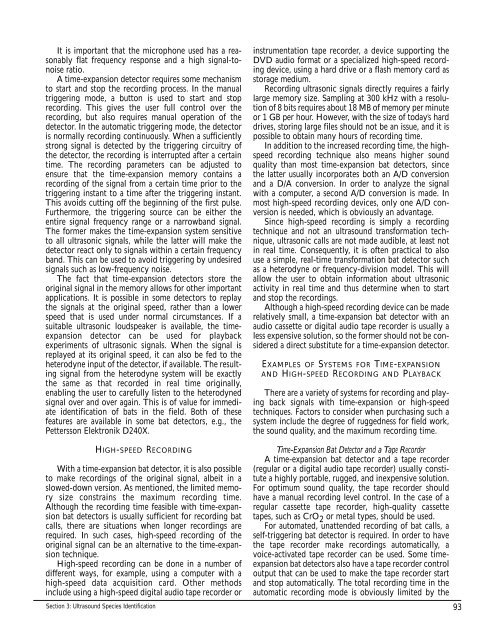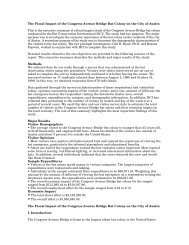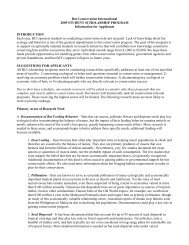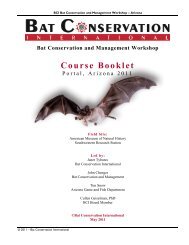Bat Echolocation Researc h - Bat Conservation International
Bat Echolocation Researc h - Bat Conservation International
Bat Echolocation Researc h - Bat Conservation International
You also want an ePaper? Increase the reach of your titles
YUMPU automatically turns print PDFs into web optimized ePapers that Google loves.
It is important that the microphone used has a reasonably<br />
flat frequency response and a high signal-tonoise<br />
ratio.<br />
A time-expansion detector requires some mechanism<br />
to start and stop the recording process. In the manual<br />
triggering mode, a button is used to start and stop<br />
recording. This gives the user full control over the<br />
recording, but also requires manual operation of the<br />
detector. In the automatic triggering mode, the detector<br />
is normally recording continuously. When a sufficiently<br />
strong signal is detected by the triggering circuitry of<br />
the detector, the recording is interrupted after a certain<br />
time. The recording parameters can be adjusted to<br />
ensure that the time-expansion memory contains a<br />
recording of the signal from a certain time prior to the<br />
triggering instant to a time after the triggering instant.<br />
This avoids cutting off the beginning of the first pulse.<br />
Furthermore, the triggering source can be either the<br />
entire signal frequency range or a narrowband signal.<br />
The former makes the time-expansion system sensitive<br />
to all ultrasonic signals, while the latter will make the<br />
detector react only to signals within a certain frequency<br />
band. This can be used to avoid triggering by undesired<br />
signals such as low-frequency noise.<br />
The fact that time-expansion detectors store the<br />
original signal in the memory allows for other important<br />
applications. It is possible in some detectors to replay<br />
the signals at the original speed, rather than a lower<br />
speed that is used under normal circumstances. If a<br />
suitable ultrasonic loudspeaker is available, the timeexpansion<br />
detector can be used for playback<br />
experiments of ultrasonic signals. When the signal is<br />
replayed at its original speed, it can also be fed to the<br />
heterodyne input of the detector, if available. The resulting<br />
signal from the heterodyne system will be exactly<br />
the same as that recorded in real time originally,<br />
enabling the user to carefully listen to the heterodyned<br />
signal over and over again. This is of value for immediate<br />
identification of bats in the field. Both of these<br />
features are available in some bat detectors, e.g., the<br />
Pettersson Elektronik D240X.<br />
HIGH-SPEED RECORDING<br />
With a time-expansion bat detector, it is also possible<br />
to make recordings of the original signal, albeit in a<br />
slowed-down version. As mentioned, the limited memory<br />
size constrains the maximum recording time.<br />
Although the recording time feasible with time-expansion<br />
bat detectors is usually sufficient for recording bat<br />
calls, there are situations when longer recordings are<br />
required. In such cases, high-speed recording of the<br />
original signal can be an alternative to the time-expansion<br />
technique.<br />
High-speed recording can be done in a number of<br />
different ways, for example, using a computer with a<br />
high-speed data acquisition card. Other methods<br />
include using a high-speed digital audio tape recorder or<br />
Section 3: Ultrasound Species Identification<br />
instrumentation tape recorder, a device supporting the<br />
DVD audio format or a specialized high-speed recording<br />
device, using a hard drive or a flash memory card as<br />
storage medium.<br />
Recording ultrasonic signals directly requires a fairly<br />
large memory size. Sampling at 300 kHz with a resolution<br />
of 8 bits requires about 18 MB of memory per minute<br />
or 1 GB per hour. However, with the size of today’s hard<br />
drives, storing large files should not be an issue, and it is<br />
possible to obtain many hours of recording time.<br />
In addition to the increased recording time, the highspeed<br />
recording technique also means higher sound<br />
quality than most time-expansion bat detectors, since<br />
the latter usually incorporates both an A/D conversion<br />
and a D/A conversion. In order to analyze the signal<br />
with a computer, a second A/D conversion is made. In<br />
most high-speed recording devices, only one A/D conversion<br />
is needed, which is obviously an advantage.<br />
Since high-speed recording is simply a recording<br />
technique and not an ultrasound transformation technique,<br />
ultrasonic calls are not made audible, at least not<br />
in real time. Consequently, it is often practical to also<br />
use a simple, real-time transformation bat detector such<br />
as a heterodyne or frequency-division model. This will<br />
allow the user to obtain information about ultrasonic<br />
activity in real time and thus determine when to start<br />
and stop the recordings.<br />
Although a high-speed recording device can be made<br />
relatively small, a time-expansion bat detector with an<br />
audio cassette or digital audio tape recorder is usually a<br />
less expensive solution, so the former should not be considered<br />
a direct substitute for a time-expansion detector.<br />
EXAMPLES OF SYSTEMS FOR TIME-EXPANSION<br />
AND HIGH-SPEED RECORDING AND PLAYBACK<br />
There are a variety of systems for recording and playing<br />
back signals with time-expansion or high-speed<br />
techniques. Factors to consider when purchasing such a<br />
system include the degree of ruggedness for field work,<br />
the sound quality, and the maximum recording time.<br />
Time-Expansion <strong>Bat</strong> Detector and a Tape Recorder<br />
A time-expansion bat detector and a tape recorder<br />
(regular or a digital audio tape recorder) usually constitute<br />
a highly portable, rugged, and inexpensive solution.<br />
For optimum sound quality, the tape recorder should<br />
have a manual recording level control. In the case of a<br />
regular cassette tape recorder, high-quality cassette<br />
tapes, such as CrO 2 or metal types, should be used.<br />
For automated, unattended recording of bat calls, a<br />
self-triggering bat detector is required. In order to have<br />
the tape recorder make recordings automatically, a<br />
voice-activated tape recorder can be used. Some timeexpansion<br />
bat detectors also have a tape recorder control<br />
output that can be used to make the tape recorder start<br />
and stop automatically. The total recording time in the<br />
automatic recording mode is obviously limited by the<br />
93
















